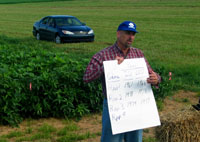Researchers Continue to Seek Slow-Rusting Soybeans
Researchers Continue to Seek Slow-Rusting Soybeans

Researchers around the country are looking to find a way to slow the development of Asian soybean rust when it infects a plant.
“There are no soybeans that we know of that are resistant to soybean rust,” said Todd Pfeiffer, soybean breeder with the University of Kentucky College of Agriculture.
That doesn’t mean efforts are not being made to find a way to make soybean plants resistant or at least partially resistant. What most scientists are working on is partial resistance or slow-rusting varieties.
“It (slow rusting) doesn’t mean that there’s no disease present,” he said. “It just means that there is a lot less and the pustules increase at a much slower rate.”
As soon as rust was discovered in Brazil, scientists recognized that it eventually would reach the United States, which it did in 2004. The U.S. Department of Agriculture began screening its soybean germplasm collection, which consists of more than 16,000 different soybean types, for any signs of resistance. The germplasm was exposed to rust at a Maryland containment facility. The results were that 776 showed some type of slow-rusting characteristic.
After identifying the slow-rusting germplasms, seeds were sent around the United States for planting. There are not a lot of seeds, but each maturity group from 00, the most northern varieties, to 10, which are from near the equator, was sent to five different locations. One southern location is growing all the varieties. UK is one of five locations growing the Group 5 maturity soybean seeds.
“We are growing all 101 of them, and if rust comes into the area we will look to see if they hold up as well in the field as they looked like they would at Fort Detrick, Md.,” Pfeiffer said. “At the same time, the USDA is increasing the amount of seed they have for each variety and will be sending them to Brazil for testing as well.”
The varieties being grown in Kentucky came from South Korea, China, Vietnam, the Republic of Georgia, Japan, Taiwan, India, Indonesia, North Korea, Nepal and Thailand.
“Some of them look good, and some of them look awful and you wouldn’t think they look much like soybeans,” he said. “But if they have this slow-rusting characteristic, they are going to be very valuable.”
UK’s plot is located at the Research and Education Center in Princeton. The plants are being evaluated only for their slow-rusting potential. If they are found to contain these characteristics, they would be incorporated into existing varieties that are yielding well, Pfeiffer said.
Work is also ongoing by the USDA and seed companies to develop complete resistance, but this has been an elusive process, he said.
Dealing with rust in soybeans is sort of like dealing with the flu in humans. Every year, officials must predict which strain of flu will be present and develop a vaccine for it. Likewise, there are several types of rust spores out there, and determining which soybean is resistant depends on which strain of rust is present.
Work on developing resistant soybeans began in Taiwan in the 1960s, and in the following years, a soybean variety was found that had a single gene for soybean resistance and it was put into varieties. However, a new rust strain came along and the variety was no longer resistant. They repeated the screening and found three more genes that were each resistant to a specific rust strain.
Scientists are using molecular engineering to put all four genes into a variety in the hopes that it will protect against rust. But any rust-resistant soybeans are likely several years away. Slow-rusting varieties are also down the road but could be more quickly available.
